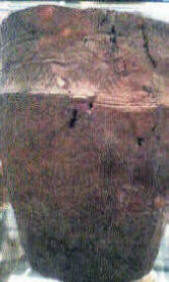
A glimpse into our ancient past at newly refurbished Museum
by THE DIGGER
 |
| The urn found in a field in Glenavy in 1898 is now on display at the newly refurbished Ulster Musum, Belfast. US4909- |
The £17m redevelopment has given a refreshing uplift to those who have an interest in our rich heritage.
The big attraction that seemed to be on every child's lips was the "mummy". There was a constant stream of onlookers visiting the Ancient Egyptian Gallery. Some were re-acquainting themselves with the remains of Takabuti the mummy, others were seeing her for the first time and also the facial reconstruction on display close by.
Takabuti, who had been laid to rest approximately 2300 years ago in a cemetery in Western Thebes, had been donated to the museum by Thomas Greg of Ballymenoch House, Holywood in 1835.
Mummification was a process that was to prepare the deceased for the "after-life".
At 11am on Tuesday January 27 1835 it was reported that about 130 gentlemen had gathered to witness the unrolling of the mummy. Dr. Marshall, Mr. Gratton, Mr. Getty and the Rev. Dr. Hincks of Killyleagh were chosen to carry out this task.
At Easter in 1851 it was reported that the custom of opening the museum to the "working classes" was continued. It had proved to be a success in former years and 1851 was no exception. On that day 3,100 visitors attended. It was stated that the leading point of attraction to the holiday folk that Easter was the female mummy.
Whilst mummification was a popular process encompassing the beliefs of the ancient Egyptians, ancients settled in our own district had their own funeral customs. At the time when Takabuti was arriving in Ireland, local farmers were levelling some of the ancient mounds and raths across the landscape and evidence of a past way of life were frequently unveiled. A number of these items from Lisburn and surrounding district were preserved and are now on display in the Ulster Museum.
In Glenavy in 1854 two urns were discovered three feet below the surface in a field belonging to local mill owner James Lorimer. A human skeleton was also found approximately five feet away. Forty four years after the unearthing another larger urn was found approximately 250 yards away. It contained a large quantity of calcined bones.
The November edition of the 1898 Ulster Journal of Archaeology records that the find was examined by Professor Cunningham of the Queen's College, Belfast. The results of his preliminary findings were inconclusive and could not provide any further information. The urn is just one of the many artefacts displayed at the Ulster Museum.
Another local exhibit is a piece of fossil wood taken from a much larger piece that had once adorned the landscape at Langford Lodge, on Lough Neagh's shore. It is believed to be 30 million years old. The Ordnance Survey memoirs from 1834 refer to this fossil as petrified wood. The memoirs state that eight horses were required to draw a large mass of petrifaction from its position below Glendarragh in the Crumlin River to the Honourable Colonel Pakenham's garden at Langford Lodge in 1824. Nennius, writing in the 9th century, refers to the petrifying power of the Lough and how it transformed wood into stone.
Scientists in the 21st century attribute this strange phenomena to the presence of "silica-rich groundwater".
A plaster cast and piece of the famous Crumlin Meteorite are also on display and visitors are informed as to the background of this unique event. The meteorite entered the earth's atmosphere and landed in a field belonging to Andrew Walker, at Crosshill, Crumlin on Saturday September 13, 1902.
It would be a fatal mistake to comply with the opening lines of Perry Como's 1958 hit "Catch a falling star and put it in your pocket." The Crumlin meteorite was found at a depth of one and a half feet below the surface of the ground and had been prevented from going deeper due to the presence of a larger boulder in the ground. The story of another meteorite discovered inside a police store at Sprucefield, Lisburn in 1969 can also be read by visitors to the museum.
Other locally sourced items on display can be found in the Art and Craft exhibition. There you can view pieces of leather off-cuts dating from the 8th to 10th century, discovered during an archaeology excavation at a ring-fort in the Lissue area of Lisburn. A visit to the newly refurbished Ulster Museum is not to be missed and you can see for yourself these exhibits and other "gems from our past."
Details of exhibits, opening times and events taking place at The Ulster Museum can be found by visiting their website at www.nmni.com.
The Digger can be contacted via The Ulster Star Office or by email diggerarticle@hotmail.com.
04/12/2009
